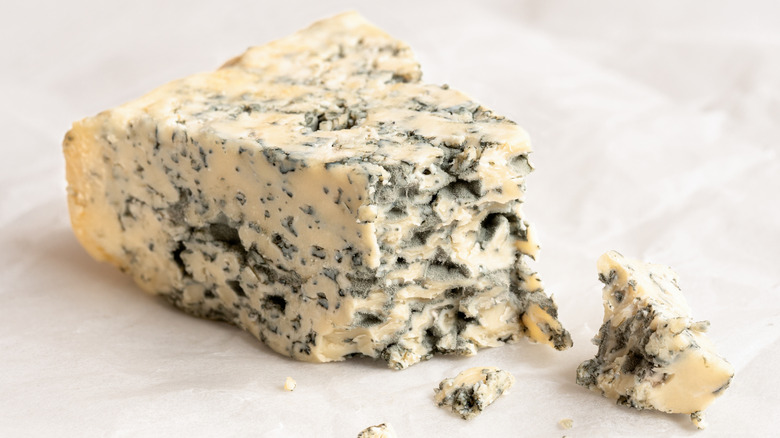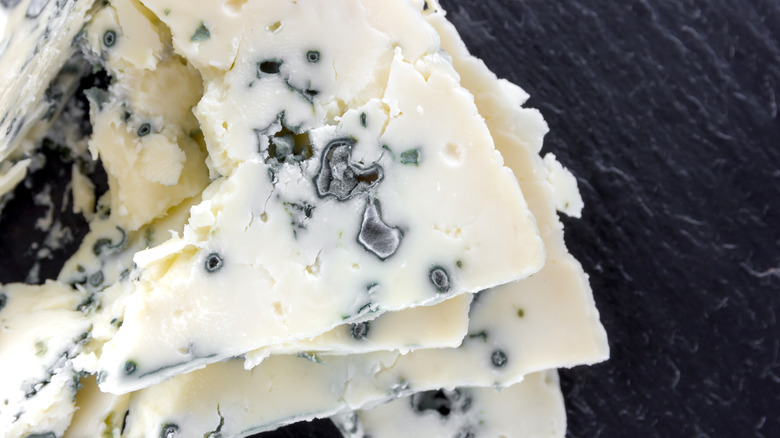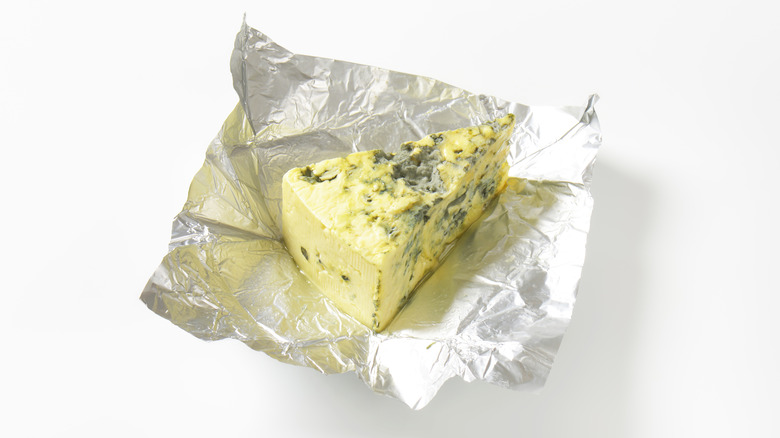Here's How You Can Tell When Blue Cheese Goes Bad
When a food is purposefully created with mold (yes, you read that right), it can be hard to tell whether or not it has actually gone bad. That's exactly the case for blue cheese, a dairy product known for its blue-green veins and strong smell. However, even with already distinctively funky characteristics like these, it's still possible for this cheese to spoil. There are a few telltale signs that will clue you in on when that has happened.
The symptoms of rotting are much easier to spot once you understand what blue cheese is and the qualities that typically define it. It's created by adding Penicillium roqueforti, a species of mold, into the milk or curd used to make the cheese. Within the weeks and months of time it has to age, the mold will grow and spread throughout the wheel, creating that infamously sharp taste, plus those trademark streaks of color and either a creamy and soft or crumbly and firm texture. Any deviation from these traits — especially visual and olfactory changes — likely indicates that the cheese has declined in quality and should be assessed for spoilage. So, if your blue cheese looks, smells, or feels drastically different from when you purchased it, you might want to reconsider giving it a taste.
Signs you should toss your blue cheese
One of the biggest hints that blue cheese has gone bad is the color. As implied by its name, this cheese is spotted with pockets of blue-green mold and has a white or cream-colored base. If either the mold or the body of the cheese starts to turn to a different color, such as black, gray, pink, or yellow, it's time to toss it out.
It's especially time to get rid of your cheese if it becomes slimy or takes on fuzzy exterior mold. Another textural cue is when it becomes overly dry and hard. Blue cheese can be creamy or crumbly, depending on which kind you buy, but even if it's meant to be firm, it shouldn't get to the point of being chalk-like. On the flip side, if you notice moisture build-up within your cheese's wrapping or container, this is a bad sign, too.
You might think odor would be tricky as a gauge for whether your blue cheese can be salvaged since it already has a pungent scent. The more sour or ammonia-like it smells, though, the better off you are discarding it. And worse comes to worst, if you see no change in appearance or texture but are still unsure if your cheese is fresh, give it a taste test at your own discretion. Otherwise, you might end up ruining your balsamic-glazed fried chicken or buffalo wings with a side of spoiled blue cheese dip.
How to extend the shelf life of blue cheese
If you're unable to go through blue cheese quickly enough, it's best to buy it in small packages so you don't need to worry about rushing to use up any leftovers. You can also leave it in the freezer, and then switch it over to the refrigerator shortly before using it (just keep in mind that its texture and flavor will change upon thawing). Otherwise, if you're putting it in the fridge to begin with, blue cheese will generally last three to four weeks if stored properly.
Your cheese should first be wrapped in either cheese paper, wax paper, parchment paper, or aluminum foil. Doing so will allow the product to breathe better than if you'd wrapped it in cling film (which would suffocate it) while still preventing moisture loss. Improper ventilation will cause the mold to die and change colors, making it unsafe to eat. So, once it's covered in the proper material, you should put the cheese in an airtight container on its own. This is because the mold in blue cheese can easily turn other cheeses blue through close contact. Storing it separately will also help to prevent the moisture in your fridge from promoting spoilage.


